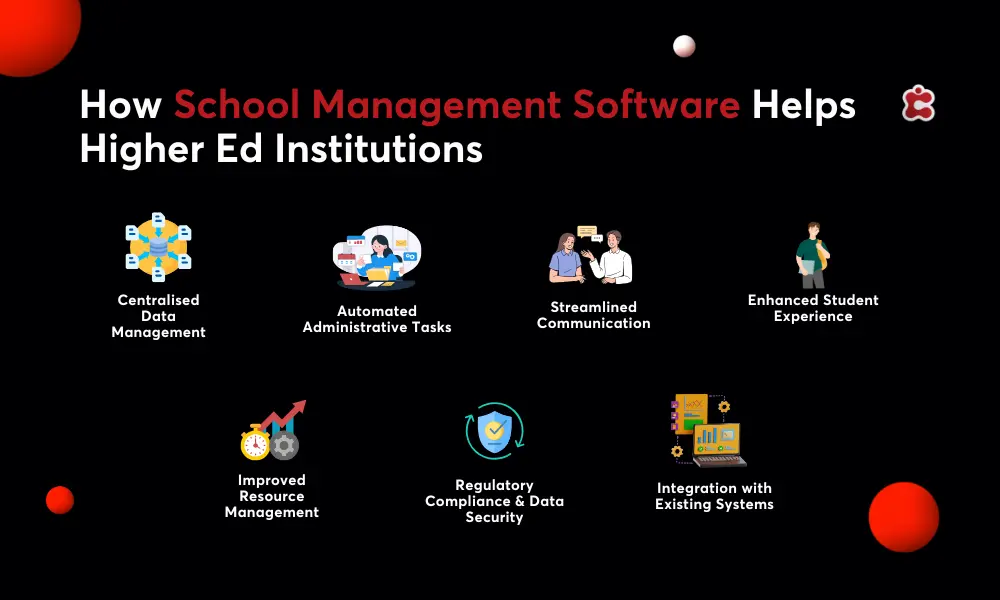It’s 2025, but many universities are still operating as if it were 2005. While student needs, teaching methods, and administrative processes have changed dramatically, many higher education institutions are still relying on legacy systems to manage it all. These outdated tools may have once done the job—but today, they’re slowing everything down. From data silos and limited scalability to poor user experiences and rising IT costs, legacy systems make it harder to stay agile and student-focused.
In this article, we’re unpacking the core challenges legacy software creates for higher ed. More importantly, we’ll walk you through what to do about it, including what to look for in a modern school management software solution. Whether you’re a university leader, IT manager, or part of the administrative team, this guide will help you see the possibilities of moving beyond the past—and into a more flexible, connected, and efficient future.

What Are Legacy Systems in Higher Education?
Legacy systems in higher education are outdated software platforms or technology infrastructures that were once state-of-the-art but have since become inefficient, hard to maintain, and incompatible with modern tools. These systems were often built in-house or customized years ago to meet specific institutional needs. While they may still function, they lack the flexibility, scalability, and integration capabilities needed for today’s digital campus.
Common examples of legacy school systems in higher education include outdated Student Information Systems (SIS), disconnected scheduling platforms, aging finance and HR systems, or manual admissions databases that don’t talk to each other. Many universities also rely on homegrown tools that are no longer supported or understood by current IT teams.
The Disadvantages of Legacy Systems in Higher Education
Lack of Integration and Data Silos
Legacy systems often can’t communicate with newer tools. This leads to fragmented data across departments—student records in one place, academic data in another, and billing information somewhere else. Without a centralized system, it’s nearly impossible to get a clear, institution-wide view.
Poor User Experience for Students and Staff
Modern users expect intuitive, mobile-friendly platforms. Legacy systems are usually clunky, slow, and hard to navigate, leading to errors, delays, and frustration on both ends of the screen.
High Maintenance Costs and Technical Debt
Older systems require ongoing patches, server upkeep, and specialized IT support. These hidden costs add up quickly and often outweigh the investment in a modern solution.
Limited Access to Real-Time Data
With no real-time syncing or dashboards, making data-informed decisions becomes slow and unreliable—especially when managing enrollment, performance, or financials.
Security and Compliance Risks
Outdated platforms may not meet current data protection standards or regional compliance requirements like GDPR. This opens institutions to serious security threats and potential penalties.
Inability to Support Remote and Hybrid Models
Legacy tools aren’t built for flexibility. Supporting online classes, hybrid schedules, or remote admin work becomes nearly impossible without modern infrastructure.
Moving Toward a Modern School Management System
The good news? Higher education doesn’t have to stay stuck with outdated systems. Modern school management software offers a centralized, cloud-based solution designed to meet the evolving needs of today’s institutions. Instead of juggling disconnected tools, universities can manage everything—admissions, student records, scheduling, billing, communication, and more—from one unified platform.
With school management software, data flows smoothly between departments, helping administrators make faster, smarter decisions. Cloud hosting means automatic updates, remote access, and better data security without relying on aging infrastructure. Students benefit, too, with easier access to grades, schedules, and academic resources. Whether you’re managing a single campus or multiple locations, a modern solution can scale as your institution grows. It’s not just about replacing old software.
Features to Look for in a Modern System
Not all school management systems are created equal. When choosing the right platform for your institution, it’s important to focus on features that truly support your goals.
Here are the must-have features to look for:
- Unified student information system that centralizes academic, administrative, and financial data
- End-to-end process management from admissions and enrollment to assessments, transcripts, and graduation
- Integrations with LMS, CRM, and finance tools to ensure seamless data flow between departments
- Cloud-hosted platform with strong data security and automatic updates for compliance and peace of mind
- Customizable setup to match the needs of multi-campus or multi-department institutions
Making the Transition: Tips for Higher Ed Leaders
1. Start with a digital transformation strategy
Define your vision, set clear goals, and map out how technology can support every part of the student journey.
2. Involve all stakeholders early
Get input from academic staff, IT teams, administrators, and even students. Their insights will help ensure a smoother rollout.
3. Choose a scalable and modular platform
Look for a solution that can grow with your institution and allows you to add features as needed, without requiring a complete overhaul.
4. Plan for data migration and user training
Ensure your team has a clear roadmap for transferring data from legacy systems and getting everyone comfortable with the new tools.
5. Emphasize long-term ROI
Focus not just on immediate costs, but on the time saved, operational efficiency, and improved student experience a modern system can deliver.
Why It’s Time to Consider Classter
If your institution is ready to leave legacy systems behind, Classter offers an all-in-one school management software designed for the complexities of higher education. Built with modularity in mind, Classter allows you to choose only the features you need.
The platform is fully cloud-based, giving your team remote access, automatic updates, and strong data security. It’s also scalable, making it a great fit for institutions of any size, whether you’re running one campus or several. Plus, the user-friendly interface makes onboarding a breeze for staff, faculty, and students alike.
Classter was built to simplify operations, reduce silos, and support the digital transformation your institution needs.
Book a free demo or learn more about how Classter can support your next step forward.
FAQ’s
Legacy systems are outdated, costly to maintain, and often create data silos. They lack integration, scalability, and real-time access, limiting institutions’ ability to adapt and innovate.
Key features include a unified student information system, cloud-based hosting, end-to-end process management, strong data security, and integration with LMS and finance tools.
Classter is modular, scalable, and built specifically for the complexities of higher education. It offers full cloud support, seamless integrations, and a highly customizable platform.

